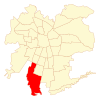San Bernardo, Chile facts for kids
Quick facts for kids
San Bernardo
|
||||||
|---|---|---|---|---|---|---|

Plaza de San Bernardo in 2012
|
||||||
|
||||||
| Country | Chile | |||||
| Region | Santiago Metro. | |||||
| Province | Maipo | |||||
| Founded | 1821 | |||||
| Government | ||||||
| • Type | Municipality | |||||
| Area | ||||||
| • Total | 155.1 km2 (59.9 sq mi) | |||||
| Elevation | 570 m (1,870 ft) | |||||
| Population
(2002 Census)
|
||||||
| • Total | 246,762 | |||||
| • Density | 1,591.0/km2 (4,120.6/sq mi) | |||||
| • Urban | 241,138 | |||||
| • Rural | 5,624 | |||||
| Sex | ||||||
| • Men | 121,535 | |||||
| • Women | 125,227 | |||||
| Time zone | UTC-4 (CLT) | |||||
| • Summer (DST) | UTC-3 (CLST) | |||||
| Area code(s) | +56 | |||||
| Website | Municipality of San Bernardo | |||||
San Bernardo (pronounced sam ber-NAR-doh) is a city in Chile. It is part of the larger Greater Santiago area. San Bernardo is also a commune, which is like a local government area. It is the main city of the Maipo Province in the Santiago Metropolitan Region. The city is also home to the Roman Catholic Diocese of San Bernardo, which is a religious area led by a bishop.
Contents
People and Population in San Bernardo
San Bernardo covers an area of about 155.1 square kilometers. In 2002, a study counted 246,762 people living there. This included 121,535 men and 125,227 women.
Most people, about 241,138 (97.7%), lived in urban areas, which are cities or towns. A smaller number, 5,624 (2.3%), lived in rural areas, which are countryside areas. The population of San Bernardo grew quite a bit between 1992 and 2002, by almost 30%.
How San Bernardo is Governed
San Bernardo is run by a municipal council. This council is led by an alcalde, who is like a mayor. The alcalde is chosen by the people in an election every four years.
The alcalde for 2016-2020 was Nora Cuevas Contreras. The council also has several members who help make decisions for the commune. These members include:
- Amparo García Saldias
- Christopher White Bahamondes
- Leonel Cadiz Soto
- Luis Navarro Ormeño
- Orfelina Bustos Carmona
- Raimundo Camus Varas
- Ricardo Rencoret Klein
- Sebastián Tapia Macaya
- Sebastián Orrego Cisternas
- Soledad Perez Peña
San Bernardo also has representatives in the national government. These representatives speak for the people of San Bernardo in the Chamber of Deputies of Chile and the Senate of Chile.
Chile's Folklore Capital
San Bernardo is known across Chile as the capital of Chilean folklore. Folklore means the traditional beliefs, customs, and stories of a community. This is because of two big events held in the commune every year. These events celebrate traditional Chilean music, dance, and crafts.
National Folklore Festival
The "Festival Nacional del Folklore de San Bernardo" happens at the end of February. It has been held every year since 1972. People from all over Chile come to watch and take part. The festival includes performances of traditional Chilean music, dancing, and singing. There are also competitions for schools and local groups. Sometimes, people from other countries are invited to share their own traditions.
Another part of the festival is the "Feria de Artesanía Tradicional." This is a fair where people show and sell traditional food, art, and crafts. These items come from Chile and other Latin American countries.
A Thousand Cuecas in April
"Abril Cuecas Mil" (which means "A Thousand Cuecas April") takes place every year on the last Saturday of April. It started in 1993, thanks to a local folklorist named Arturo García Araneda. This event focuses on the Cueca, which is Chile's national dance.
The event lasts for about 30 hours straight! Musicians and groups play a thousand Cuecas, and anyone can join in the dancing. People of all skill levels, from beginners to professional dancers, come to enjoy the music and dance.
Chena's Pucará: An Ancient Site
The Chena hills, near San Bernardo, are home to an ancient Incan site. It is known as the Huaca of Chena or Chena's Pucará. At first, people thought it was a fortress. However, it is now understood to be a huaca, which is a sacred place used for special ceremonies.
This structure on the Chena hills looks like a puma from above. This animal shape is common in Incan sacred buildings. The word "Chena" itself means "puma in heat" in the Quechuan language, which was spoken by the Incas.
Later studies showed that the site has three main parts. These are an outer wall, a middle wall, and a central area. This design fits with how the Incas often built their sacred places. The main part of the structure also looks like an Incan Ushnu, which was a place for observation. It seems that the main altar of the site lines up perfectly with the first rays of the sun during the winter and summer solstices (June 21 and December 21). This suggests it was used to observe the sun.
Today, San Bernardo does not have enough resources to properly care for this important site. Chena's Pucará is not well maintained or protected. However, in recent years, local Quechuan and Aymará people have shown interest in working with authorities. They want to gain rights to use the area for their own traditional ceremonies.
Sports Teams
San Bernardo is home to a few sports teams, including:
- San Bernardo Unido
- Atlético San Bernardo
See also
 In Spanish: San Bernardo (Chile) para niños
In Spanish: San Bernardo (Chile) para niños





